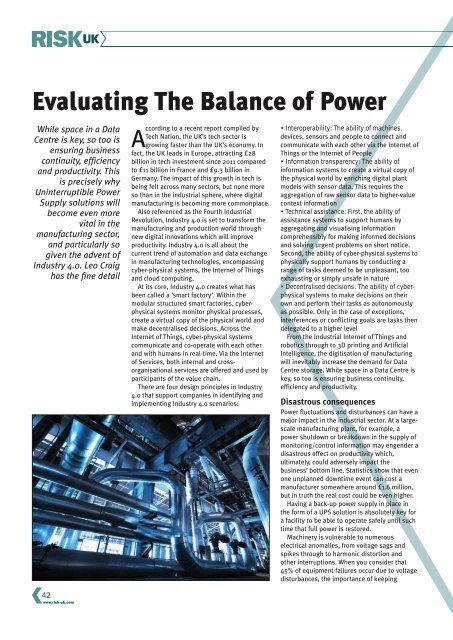RiskUKApril2017
You also want an ePaper? Increase the reach of your titles
YUMPU automatically turns print PDFs into web optimized ePapers that Google loves.
Evaluating The Balance of Power<br />
While space in a Data<br />
Centre is key, so too is<br />
ensuring business<br />
continuity, efficiency<br />
and productivity. This<br />
is precisely why<br />
Uninterruptible Power<br />
Supply solutions will<br />
become even more<br />
vital in the<br />
manufacturing sector,<br />
and particularly so<br />
given the advent of<br />
Industry 4.0. Leo Craig<br />
has the fine detail<br />
42<br />
www.risk-uk.com<br />
According to a recent report compiled by<br />
Tech Nation, the UK’s tech sector is<br />
growing faster than the UK’s economy. In<br />
fact, the UK leads in Europe, attracting £28<br />
billion in tech investment since 2011 compared<br />
to £11 billion in France and £9.3 billion in<br />
Germany. The impact of this growth in tech is<br />
being felt across many sectors, but none more<br />
so than in the industrial sphere, where digital<br />
manufacturing is becoming more commonplace.<br />
Also referenced as the Fourth Industrial<br />
Revolution, Industry 4.0 is set to transform the<br />
manufacturing and production world through<br />
new digital innovations which will improve<br />
productivity. Industry 4.0 is all about the<br />
current trend of automation and data exchange<br />
in manufacturing technologies, encompassing<br />
cyber-physical systems, the Internet of Things<br />
and cloud computing.<br />
At its core, Industry 4.0 creates what has<br />
been called a ‘smart factory’. Within the<br />
modular structured smart factories, cyberphysical<br />
systems monitor physical processes,<br />
create a virtual copy of the physical world and<br />
make decentralised decisions. Across the<br />
Internet of Things, cyber-physical systems<br />
communicate and co-operate with each other<br />
and with humans in real-time. Via the Internet<br />
of Services, both internal and crossorganisational<br />
services are offered and used by<br />
participants of the value chain.<br />
There are four design principles in Industry<br />
4.0 that support companies in identifying and<br />
implementing Industry 4.0 scenarios:<br />
• Interoperability: The ability of machines,<br />
devices, sensors and people to connect and<br />
communicate with each other via the Internet of<br />
Things or the Internet of People<br />
• Information transparency: The ability of<br />
information systems to create a virtual copy of<br />
the physical world by enriching digital plant<br />
models with sensor data. This requires the<br />
aggregation of raw sensor data to higher-value<br />
context information<br />
• Technical assistance: First, the ability of<br />
assistance systems to support humans by<br />
aggregating and visualising information<br />
comprehensibly for making informed decisions<br />
and solving urgent problems on short notice.<br />
Second, the ability of cyber-physical systems to<br />
physically support humans by conducting a<br />
range of tasks deemed to be unpleasant, too<br />
exhausting or simply unsafe in nature<br />
• Decentralised decisions: The ability of cyberphysical<br />
systems to make decisions on their<br />
own and perform their tasks as autonomously<br />
as possible. Only in the case of exceptions,<br />
interferences or conflicting goals are tasks then<br />
delegated to a higher level<br />
From the Industrial Internet of Things and<br />
robotics through to 3D printing and Artificial<br />
Intelligence, the digitisation of manufacturing<br />
will inevitably increase the demand for Data<br />
Centre storage. While space in a Data Centre is<br />
key, so too is ensuring business continuity,<br />
efficiency and productivity.<br />
Disastrous consequences<br />
Power fluctuations and disturbances can have a<br />
major impact in the industrial sector. At a largescale<br />
manufacturing plant, for example, a<br />
power shutdown or breakdown in the supply of<br />
monitoring/control information may engender a<br />
disastrous effect on productivity which,<br />
ultimately, could adversely impact the<br />
business’ bottom line. Statistics show that even<br />
one unplanned downtime event can cost a<br />
manufacturer somewhere around £1.6 million,<br />
but in truth the real cost could be even higher.<br />
Having a back-up power supply in place in<br />
the form of a UPS solution is absolutely key for<br />
a facility to be able to operate safely until such<br />
time that full power is restored.<br />
Machinery is vulnerable to numerous<br />
electrical anomalies, from voltage sags and<br />
spikes through to harmonic distortion and<br />
other interruptions. When you consider that<br />
45% of equipment failures occur due to voltage<br />
disturbances, the importance of keeping

















